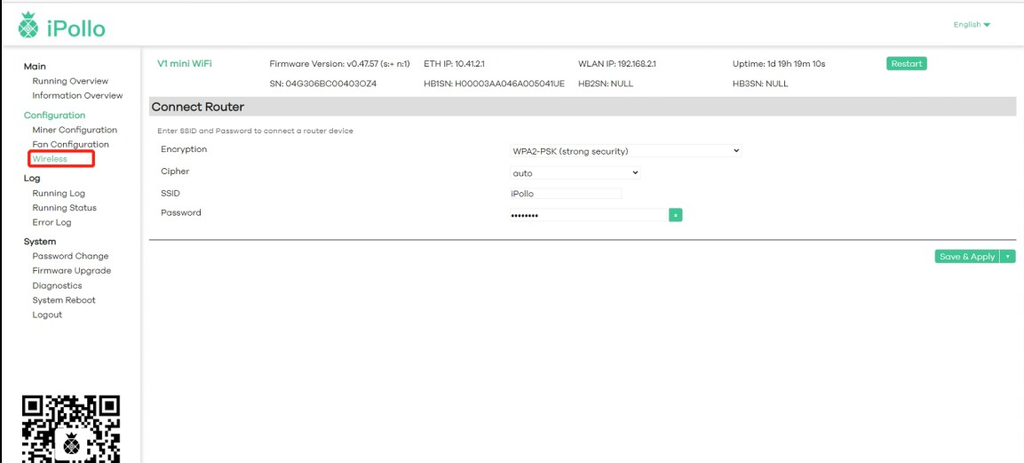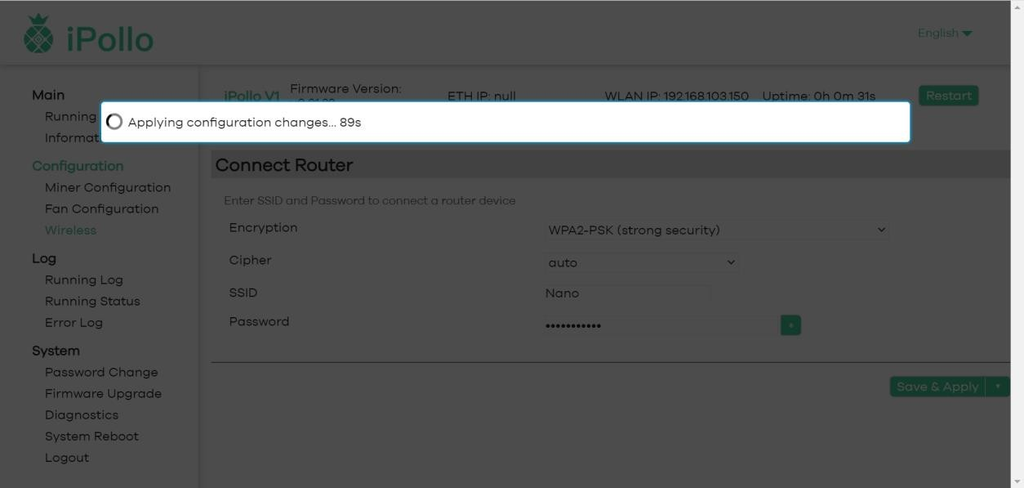|
Content |
Parameter |
|
Model No |
iPollo V1 mini (WiFi) |
|
Crypto Algorithm /coin |
Ethash/ETH |
|
Hashrate(TH/s) |
300(±10%) |
|
Operation temperature(℃) |
10-25 |
|
Power consumption(W) |
240(±10%) |
|
Memory |
Design memory-6 GB, available memory-5.8 GB |
I.V1 mini: Check Before Use
1.Sign ForInspection

2.Notes

1) power cable
2) WiFi signalreceiver
3) V1mini
4) power adapter(the pictures are for reference only, please refer to actual)


|
Fault |
The fault warning light. In most cases, when this light flash, it indicates that a fault has occurred |
|
Normal |
Running indicator light. In most cases, when this light is on, it indicates that the machine is working normally |
|
Reset |
Server factory reset button |
|
IP Report |
Use the show IP software to feed back the IP of this server to the computer |
|
TF card |
SD card slot |
|
Power |
Power interface |
|
ANT |
WIFI antenna |
|
ETH |
Network interface |

1.ServerConnection
The V1 mini WiFi dedicated power supply has two 6PIN DC outputs, and the input of the power supply is 100~240VAC. The server can work normally after confirming that the connection is good.

The interface marked “ETH” on the server interface panel is the network cable interface. Pay attention to the direction when inserting the cable. Please insert the crystal head in place. After inserting it in place, you will usually hear a light “click” sound.


(2-2) WiFi Connection
The red box in the picture is the WiFi antenna ,WiFi signal can be connected, For details, please visit “ipollo.com/support”.

2.Log in to theServer
After the server is powered on and connected to the Internet, it starts to start. After the server’s normal starts to light up, you can find the IP of the server. You can use the “show IP” software to find the server IP as follows:

Note: The server and PC must be in the same network segment, otherwise the IP information returned by the server cannot be received.


3.ServerSettings
Click the "Miner Configuration" interface of "Configuration" to set the "Mining Pool" and "Network"

Note: This manual takes the “poolin” as an example.
(1)Select "Pool Configuration" and fill in the Mining Pool Information
(1-1) The "Url" in "Mining Pool 1" is filled with the ETH Poolin mining link address: stratum+tcp://eth.ss.poolin.one:443
(1-2) "Worker" in "Pool 1" fill in "ipollomini.001"; "ipollomini" is a custom "sub-account" in the corresponding Mining Pool account; the number suffixed with ".001" is the number used to distinguish the server;).
Note: For customization such as numbers or letter combinations, use English periods to separate them, only modify the corresponding characters, and do not increase or decrease spaces and punctuation).
Note: In order to prevent “Pool 1” from being disconnected, causing the server to not work, it is recommended to set “Pool 2” and “Pool 3” at the same time, so as to ensure that the system will automatically switch to “Pool 2” or "Pool 3” for normal operation when “Pool 1” goes offline.
Regarding network connection, V1 mini Series products are divided into two models: "wired connection" and "WiFi connection". You can set the server according to the corresponding model obtained by following the instructions below:

(2-1) Select “DHCP (Dynamic)” State:The server automatically obtains an IP address

After setting, click “SAVE&APPLY”, the system will save and automatically restart to take effect, and the server will start to run normally.
End here, the configuration of the server has been completed, congratulations on your becoming a miner.
(2-2) Select “Static” State

(a) Enter the IP address, netmask, gateway, and DNS-Server in turn in the four boxes below, then click “SAVE&APPLY”.
(b) After the page buffering is completed, the configuration of the server has beencompleted, congratulations on your becoming a miner.

Note: The protocol information filled in "Network Configuration" in the figure (staic) is for reference only, please refer to the on-site network protocol information for details.
3.2.2 WiFiconnection
1) After the V1 mini WiFi server is powered on, it will send out the WiFi signal "iPollo_XXXXX"; turn on the laptop and connect to the wireless signal"ipollo_XXXXX"

2) Browse the server's default IP address "192.168.2.1" on the website to enter the serverlogin interface:

3) Enter Password "root" to enter the server background control interface, click "Wireless"to enter the wireless setting interface

4) Modify the SSID and corresponding password (please make sure there can be no errors,otherwise the server cannot connect to the correct network)

5) Click "Save and Apply" afterediting


6) After the application, the server needs to be powered off andrestarted;
7) The laptop is connected to the wireless signal "Nano (the network of the environment wherethe computer belongs)"

8) Openthe showIP tool, and press the "IP report" button of the server to obtain the new IP address of the server, which is the IP of the WiFi

9) Use Google Chrome, log in to the IP displayed by the above tool showIP, you can enter theserver management background, and fill in the mining pool information to complete the server
3.Login PasswordModification
If you need to change the server login password, the operation method is as follows:

Note: The “poolin” mining pool is used as an example above. If you use other mining pools, please modify it to the address of the mining pool you want to use and refer to the corresponding mining pool operation instructions.
Caution: Changes or modifications not expressly approved by the party responsible for compliance could void the user's authority to operate the equipment.
NOTE:This equipment has been tested and found to comply with the limits for a Class B digital device, pursuant to part 15 of the FCC Rules. These limits are designed to provide reasonable protection against harmful interference in a residential installation. This
equipment generates, uses and can radiate radio frequency energy and, if not installed and used in accordance with the instructions, may cause harmful interference to radio
communications. However, there is no guarantee that interference will not occur in a particular installation. If this equipment does cause harmful interference to radio or
television reception, which can be determined by turning the equipment off and on, the user is encouraged to try to correct the interference by one or more of the following measures:
--Reorient or relocate the receiving antenna.
--Increase the separation between the equipment and receiver.
--Connect the equipment into an outlet on a circuit different from that to which the receiver is connected.
--Consult the dealer or an experienced radio/TV technician for help.
Wechat
Telegram
Twitter
Discord